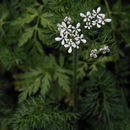Biology
provided by Arkive
This annual plant tends to germinate in October and early November (2), and flowers between May and August (1). The seeds are not able to stay dormant for long, so the plant is at risk of local extinction during times of unsuitable habitat management (2).
Conservation
provided by Arkive
This plant is a UK Biodiversity Action Plan (UKBAP) priority species. Plantlife, the wild plant conservation charity, is the lead partner responsible for coordinating the implementation of the Species Action Plan devised to guide the conservation of shepherd's needle. This plan aims to maintain the current range of the plant and to aid the recolonisation of former sites. A further proposal is the establishment of an ex-situ population, which would provide a source for potential reintroductions, and preserve the genetic diversity of the species (2).
Description
provided by Arkive
Shepherd's needle is a member of the carrot family (3), has highly divided 'frizzy' pinnate leaves and produces tiny white flowers arranged in clusters called umbels (1). The fruits can reach up to 80 mm in length and are long, narrow and pointed; it is these structures that the common name refers to (1). The Latin name pecten-veneris means 'Venus's comb'; this name arose because the fruits tend to be arranged side-by-side, and were thought to look like a comb (4).
Habitat
provided by Arkive
Inhabits arable fields, wasteland and coastal sites subject to disturbance, and shows a preference for heavy clay soils (2).
Range
provided by Arkive
Once known throughout much of the UK, and considered common until the 1950s (5), this species has suffered a precipitous decline and is now restricted to the south and east of England (2). Elsewhere, the species occurs in Europe reaching north to Denmark and west to the UK, it has also declined in eastern and north-western Europe (2).
Status
provided by Arkive
Classified as Nationally Scarce in Great Britain (2).
Threats
provided by Arkive
Like many arable 'weed' species, shepherd's needle has suffered as a result of agricultural changes including the use of chemical fertilisers and herbicides, changes in crop rotation practices, the loss of field-margins and the introduction of highly competitive types of crops (2). A particular threat seems to have been stubble burning, which was banned in the early 1990s. Since the ban there is some evidence to suggest that the species has begun to recover in some areas (5).

